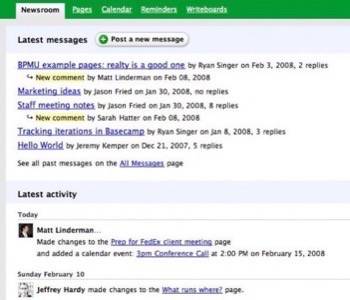This week, 37Signals started to preview the upcoming update to their Backpack service, which received its last major update in July. Though most of the new features seem very useful, they also seem to transform the app from a simple organizational tool into something else entirely. We can’t help but wonder, considering the company wrote the book on keeping things simple in software development, has 37Signals lost focus with Backpack?

First, the updates. Monday, 37Signals CEO Jason Fried posted a preview of the new Backpack multiuser feature on the company’s popular blog. Users have always been allowed to share Backpack pages and update them collaboratively — a helpful feature that I have personally used to do things like manage a closed alpha test of a web app. The new multiuser feature takes that collaborative ability a step further by letting people create and link Backpage pages from a single common area.
Then yesterday, Fried announced two more new Backpack features: messages and newsroom. Messages is just what it sounds like, a message board where users of the same Backpack project can talk to one another. While newsroom is an activity feed for the Backpack. For any 37Signals fan these features should sound familiar because they already exist in one of the company’s other popular applications, Basecamp. Basecamp is a great groupware tool that we rely on daily to manage our activities here at ReadWriteWeb. Backpack is starting to feeling a lot like Basecamp in a different skin.
With the addition of messages and an activity feed, both apps now sport more or less the exact same feature set. Both have lists, messages, files, and writeboards. The main difference is in the way those things are displayed and how much control users have over them. While Basecamp breaks everything out into separate pieces, Backpack combines them all on a single page in any configuration you want. Both approaches have their merits, but is it necessary that they exist as separate apps?
The implications of the upcoming changes haven’t been lost on users. “Cool. So Backpack is the new Basecamp with a better calendar,” wrote user Jim on the 37Signals blog. “Does anyone else now feel like Backpack will have too much,” chimed in Tim. “With the announcement of these new features (which are great), the difference b/w Basecamp & Backpack is starting to blur.”
When others echoed the sentiment, Fried responded. “Basecamp is your project management tool, Backpack is your company intranet,” he wrote. “Basecamp and Backpack are entirely different products for different purposes. We use both for very different things.”

But while Basecamp and Backpack still have some major differences when it comes to things like permissions handling, which drastically effects the use cases for each, they do now share most of the same features. That brings me back to the question about whether 37Signals has lost focus with the app.
When I saw Jason Fried speak at the BIF-3 Collaborative Innovation Summit last fall, Fried was asked by the Wall Street Journal’s Walt Mossberg, how do you avoid feature creep? According to Fried, the key is the ability and willingness to say no. “You have to be a hard ass,” he told Mossberg. So with Backpack going from a simple, single person organizational tool to what Fried now describes as a “company intranet,” has 37Signals lost focus and succumbed to feature creep? Are they not eating their own dogfood, so to speak?
The answer is a firm maybe. When talking about feature selection in their popular book about their software development methods Getting Real, the company writes that when building a web application you should start with just the single core feature. Say “no” to all the others. But that doesn’t mean to you always have to say no to new features. “Start off with a lean, smart app and let it gain traction,” they write. “Then you can start to add to the solid foundation you’ve built.”
That is more or less what they’ve done with Backpack. Started lean, let is get traction, then expanded it to where they thought it should go. But as an application Backpack has clearly evolved beyond a simple organizational tool to something that is starting to resemble their Basecamp application (which we, incidentally, already basically use as our intranet). Whether they’ve fallen prey to feature creep will really be measured by the response of their users. If people remain confused over the difference between Backpack and its cousin Basecamp, then the answer is yes, somewhere they stopped following their own advice and said “yes” to one too many feature that was better suited to one of their other applications. But if people embrace both apps as complimentary offerings, as Fried clearly hopes they will, then they’ve made the right decisions.
37Signals offers a range of applications, from simple, single-function apps like Ta-Da Lists (to-do lists), Writeboard (collaborative word processor), and Campfire (group chat) to more complicated apps like Basecamp (project management) and Highrise (group contact manager).
In the past, 37Signals has often integrated its simpler products into its more complicated offerings. Basecamp has Campfire chats, Writeboard shared writing spaces, and to-do lists clearly based on Ta-Da, for example. Along with their slow shift toward full OpenID support, this points to the potential for a modular, create-your-own app system from 37Signals, where users could pick and choose which of the company’s applications to install. That’s completely speculation on our part, but we really hope that’s the direction 37Signals is headed.
What do you think? Has 37Signals lost focus with Backpack? Or do you still see differences distinct enough between Basecamp and Backpack that you could see yourself using both? Do you wish the functionality of both applications was merged into a single app? Let us know in the comments below.










